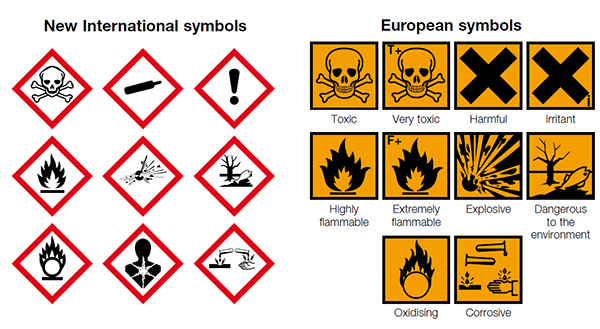
Control of Substances Hazardous to Health
COSHH Risk Assessments by Product:
A B C D E F G H I J K L M N O P Q R S T U V W X Y Z
We, as your employer, are responsible for taking effective measures to control exposure of workers to materials, chemicals and dust that may be hazardous to health.
The risks to long-term health are prolonged exposure to hazardous substances that can cause lung disease in later life such as asthma, asbestosis and cancer. Many substances we use in the workplace are potential skin irritants and you can develop debilitating and long-term dermatitis with prolonged exposure.
The irony that some workers are particularly susceptible to developing dermatitis from prolonged contact with the ‘lubricating’ powder used in rubber protective gloves to help put them on so you can protect yourself from other chemicals … just goes to show you must be aware that even the most innocuous of chemicals like talcum powder can sometimes damage your health.
Substances can also have other dangerous properties. They may be flammable, and we use many paints and materials that are solvent-based and give off flammable vapour. Even clouds of dust from everyday materials, such as wood dust, can explode if ignited in a confined space.
As part of the risk assessment we carry out on every job, you should consider:
- Does any product you use have a danger label?
- Does your process produce gas, fume, dust, mist or vapour?
- Is the substance harmful to breathe in?
- Can the substance harm your skin?
- Is it likely that harm could arise because of the way you use or produce it?
- What are you going to do about it?
- Use something else?
- Use it in another, safer way?
- Control it to stop harm being caused?
Steps you should take as the worker using potentially hazardous substances
- Review the material you are about to use, and identify if it contains any harmful substances or dangerous physical properties you should be aware of before you start using it. All products we use are sourced from reliable and responsible suppliers conforming to the extensive regulation of labeling potentially hazardous materials.
- Read the manufacturer's instructions on how to use and dispose of the product and then comply with the information and restrictions recommended.
- If you are about to use a new material or substance potentially hazardous to your health, make sure you read the manufacturer's data sheet before using it. These documents contain information about what risks you will be exposed to by using the material and make recommendations about what precautions you should take to avoid harm. We provide below a selection of data sheets for the common materials we use on site every day.
- If you are about to use a substance that is potentially harmful to your health, think about ways you can:
- use a less harmful alternative
- prevent breathing in any gases, fumes, mist or dust
- avoid direct contact with the skin
- avoid swallowing (e.g. by trying to tube siphon by mouth)
- avoid swallowing by indirect transfer by not washing your hands before by eating or smoking
- prevent contact with eyes
- avoid absorption through cuts and open wounds
The use of appropriate PPE, adequate ventilation in confined spaces, and minimising contact exposure with hazardous materials are all sensible procedures to adopt. The best solution, however, is to consider using a safer alternative.
Hazard Labels
We reproduce the current hazard labels you should be aware of. The international symbols do not have specific risks associated with each design in the same way as the European counterparts. They are intended to alert the user for the need to read the manufacturer's instructions before use to promote personal safety and protect health.

Data sheets
There follows a series of data sheets of the materials and substances we have in common use on our sites. The list is not intended to be exhaustive and can only ever reflect the most common materials and substances we currently stock and distribute to workers at this time.
It therefore follows, that a responsibility exists for workers at all levels to inform Head Office of any new materials or substances they intend to use that is not listed here, so we can decide whether to just add the required data sheet to the Head Office Date Sheet File available for staff to access for occasional use, or perhaps adding the data sheet to this list for more frequent access.
1. Crown paints.
4. Acrylic Sealant.
5. Adgrip.
8. HSS Grease.
9. Maintenance Lubricating Spray.
10. Mitre Kit Activator.
11. Silicon Spray.
13. Fire Cement.
If you have any concerns or ways to improve Health and Safety then please communicate them to our management. Most accidents and risks to long-term health can be avoided if the hazards that cause them can be identified and eliminated.

Marisco Group
Head Office:
Unit J5, The Fulcrum
Vantage Way, Poole, BH12 4NU
Tel: 01202 474001
Email: accounts@mariscosouth.com







